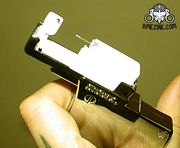Piercing Gun
Jump to navigation
Jump to search
A piercing gun, traditionally used by mall stores for piercing ears, is typically inappropriate for piercing of any kind. Almost all medical professionals agree that piercing guns cannot be adequately sterilized (an alcohol wipe is not sterilization); this means that they are capable of passing hepatitis and other diseases.
In addition, experience has taught the industry that:
- Ear piercing studs are dull and tear through the body, causing unnecessary pain, healing duration, and other possible complications.
- Ear piercing guns are inaccurate and not designed for piercing most body parts, resulting in improper piercing placement.
- Ear piercing studs are the wrong size and too short for most piercings. The small gauge (generally 20g) and short length are not optimal for healing.
Any piercer using a piercing gun should be avoided.
